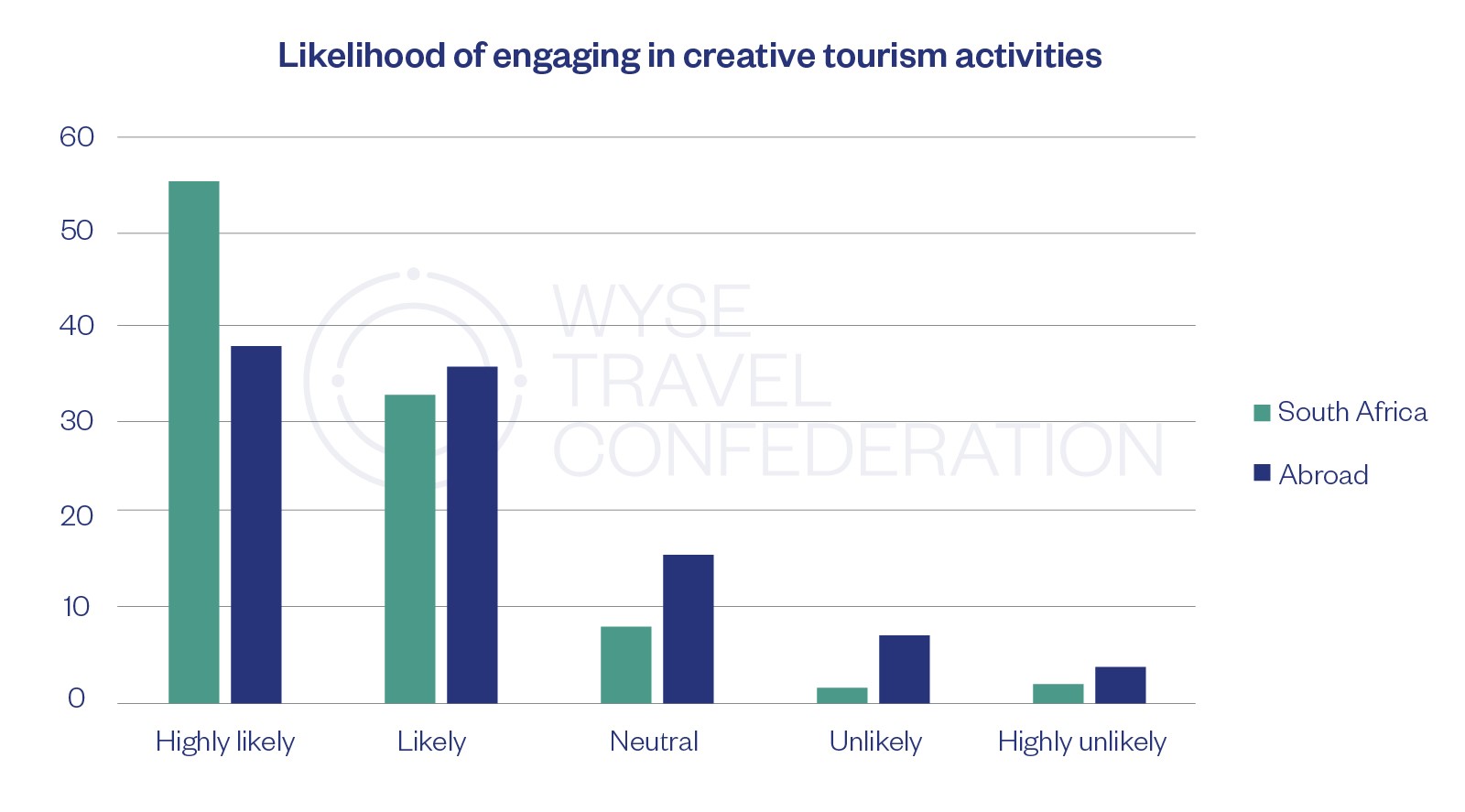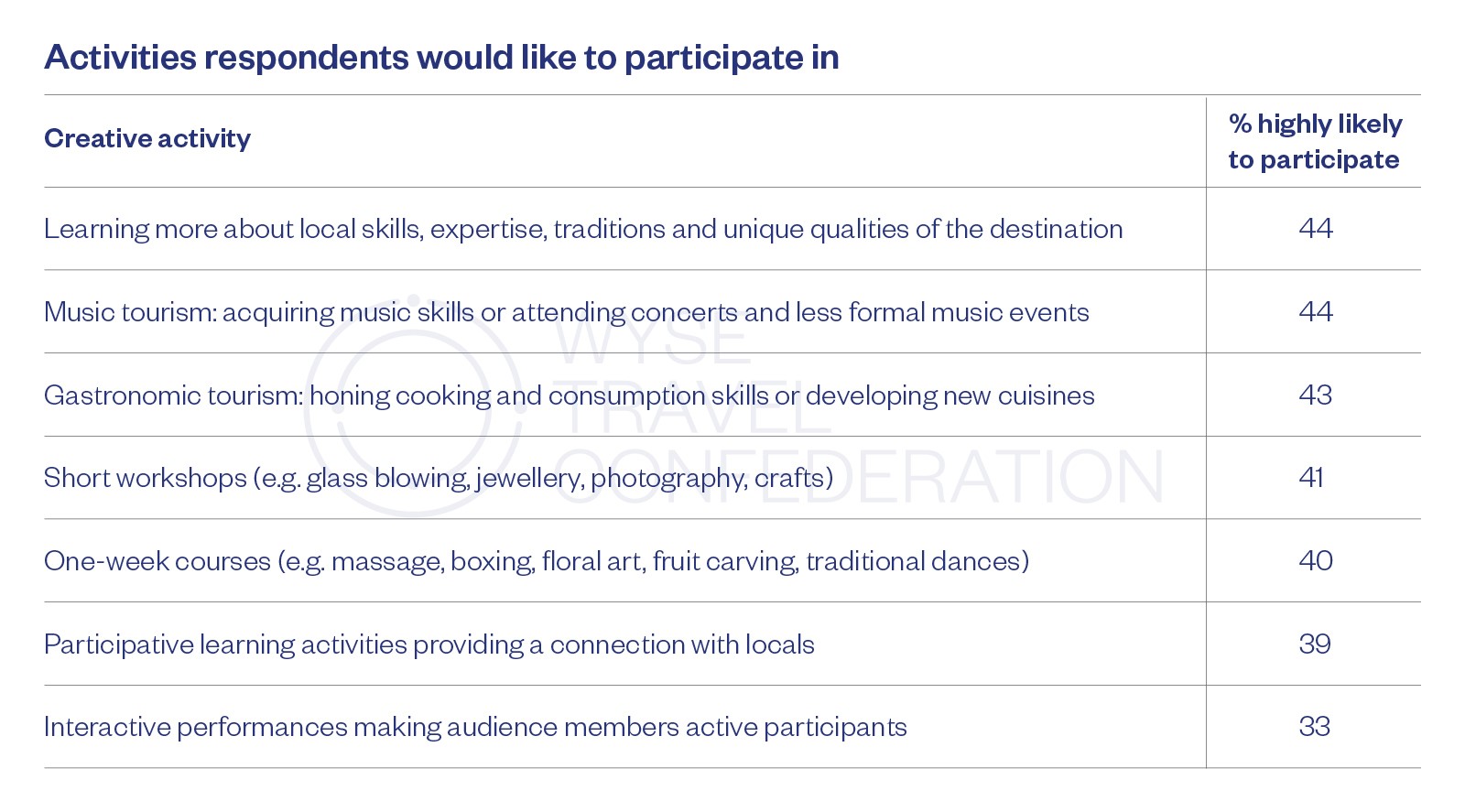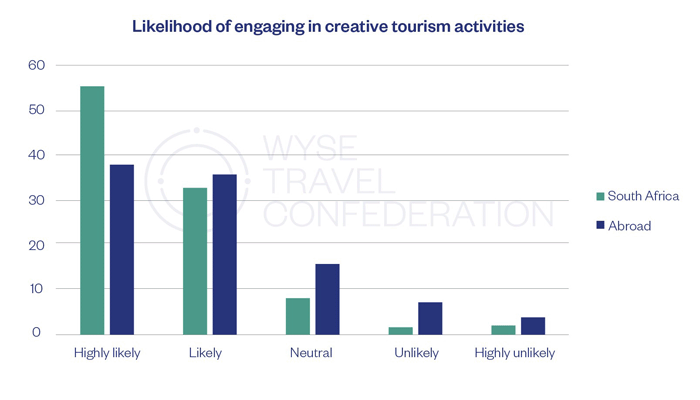Creative tourism, or the active participation by tourists in creative activities in the destination, was one of the growth areas for youth tourism identified by WYSE Travel Confederation as far back as 2005 (WYSE/UNWTO, 2005). There have been a number of studies of creative tourism demand by academics over the years, but most of these relate to creative tourism participants, rather than measuring demand among the population as a whole.
In a new study of creative tourism demand in South Africa, Anneli Douglas (University of Pretoria), Gijsbert Hoogendoorn (University of Johannesburg) and Greg Richards (Tilburg University), used a national panel of South Africans to conduct the first nationally representative study of creative tourism demand (Douglas et al., 2023a). The aim of the study was to develop a market segmentation of millennial tourists on the basis of their profile, motivations and potential demand for creative tourism activities.
Creative tourism was defined by Richards and Raymond (2000) as “tourism which offers tourists the opportunity to develop their creative potential through active participation in courses and learning experiences which are characteristic of the destination where they are undertaken”. This definition was presented to the respondents to find out if they were motivated to participate in such activities.
Millennials (individuals born between 1980–1996) are important for the tourism industry because of their desire for authentic experiences, altruistic behaviour, and extensive use of Web 2.0 technologies. In South Africa, millennials are a unique cohort, as the first post-apartheid generation. There are 15.6 million millennials in South Africa, constituting 26.6% of the population. They are now one of the largest groups in the economically active population, and they are the parents of Gen Zs.
Data were collected by a South African research company using an online panel of 40,000 individuals, targeting South African aged between 24 and 39 with a tertiary qualification. Respondents were asked about the likelihood of engaging in creative tourism activities in South Africa and abroad, therefore covering both domestic and international tourism. 1,530 completed questionnaires were collected. Most of the respondents were Black Africans (66.5%), and almost an equal number of males (48.8%) and females (51.2%), and an average age of 29 years.
The survey revealed a high level of potential demand for creative tourism, with over 55% saying they were highly likely to engage in creative tourism in South Africa, and almost a third saying they were likely to do so. The potential for outbound creative tourism was significantly lower, but over 70% of respondents still said they would be highly likely or likely to do creative tourism. The lower potential demand for international creative tourism is understandable given the limited economic means of many respondents.
Four motivational factors were found to be important in explaining domestic creative tourism demand, in order of decreasing importance:
- To gain knowledge and skills
- Unique and once-in-a-lifetime experiences
- To earn respect
- Escape
The best predictor of whether respondents will engage in domestic creative tourism activities was found to be the ‘to gain knowledge and skills’ motivational factor. The respondents were segmented on the basis of these dimensions as well as their background characteristics. The group with the highest propensity to engage in domestic creative tourism was the ‘Learner and escapist’ group, who valued learning activities as well as wanting to get away from it all – a kind of ‘edutainment’ motivation.
For international travel four different factors were found to influence creative tourism potential:
- To gain knowledge and skills
- Escape
- To earn respect
- Gender
Escape was found to be a more important factor than for domestic travel, and for international creative tourism activities, the ‘male learners in search of escape’ and the ‘I’d rather escape than learn’ segments showed the highest likelihood of participation.

Overall, the research indicates that South African millennials have a relatively high likelihood of participating in creative tourism. Creative tourism research in Menorca (Orfila-Sintes et al., 2021) indicated that 28% of international visitors had previously undertaken creative tourism activities, which is a lower level of participation than indicated by our South African respondents. To some extent this represents a gap between potential participation (as in the case of the South African survey) and actual participation (as in the case of the Mallorca survey). It may also indicate that creative tourism is particularly high for Millennials (and youth tourists in general). WYSE Travel Confederation’s New Horizons research indicated that over 70% of youth travellers were motivated at least partly to travel in order to develop their creativity.
In the South African study one interesting finding was that males were more likely than females to participate in creative activities when travelling. This contrasts with many studies that find that participation in creative activities tends to be higher for females. Not surprisingly, South African millennials are more likely to engage in domestic creative tourism activities than travelling internationally. This difference could be explained by the lack of disposable income among younger people, particularly in the black community.
Among the types of creative activities that participants were most interested in, local skills, music tourism and gastronomic tourism were the most popular choices. In general, millennials seemed more interested in learning and acquiring skills than being actively involved connecting to locals or participating in interactive performances.
The authors conclude that there is an emerging demand for active, authentic learning experiences that offer a chance for immersion into the local culture. They suggest that South African creative tourism attractions should therefore focus on increasing visitors’ skills and providing a learning experience. The researchers suggest a wide range of areas for product development in creative tourism, including making African arts and crafts and taking part in traditional cooking and traditional African beer brewing classes, taking African literature and philosophy courses, playing in African Jazz improvisation sessions and practising African martial arts. Creative tourism experiences are already being offered in cities such as Cape Town, as highlighted by the Culture Trip’s listings. WowZulu also provides tours based on creative arts in rural areas of KwaZulu-Natal. There are also opportunities to develop creative tourism with indigenous communities, which were found to be a particular attraction for cultural tourists in South Africa (Douglas et al., 2023b).
Another area where creative tourism can be developed in through a link with ‘township tourism’ (Booyens and Rogerson, 2019). There are a wide range of creative experiences available in townships based on music, food, theatre and dance, provided by companies like Coffeebeans Routes. This company also provides creative tourism experiences in Kenya, Rwanda and Uganda.
South African Tourism is now actively promoting creative experiences in the country, for example in the form of ‘art holidays to inspire creativity’. These include painting holidays, art and photography courses and combining creative activities with gastronomic experiences and sports activities.
References
Booyens, I. and Rogerson, C.M. (2019), “Creative tourism: South African township explorations“, Tourism Review, Vol. 74 No. 2, pp. 256-267.
Douglas, A., Hoogendoorn, G. & Richards, G. (2023a) Millennials as potential creative tourists in South Africa: A CHAID approach to market segmentation. Journal of Policy Research in Tourism, Leisure and Events.
Douglas, A., Hoogendoorn, G. & Richards, G. (2023b) Activities as the critical link between motivation and destination choice in cultural tourism. Journal of Hospitality and Tourism Insights.
Orfila-Sintes, F., Méndez-Durón, R., Rejón-Guardia, F., & Martín-Sintes, I. (2021). Viabilitat del turisme creatiu a Menorca. Revista de Menorca, 100, 177-188.
Richards, G., & Raymond, C. (2000). Creative tourism. ATLAS news, 23(8), 16-20. https://www.researchgate.net/publication/254822440_Creative_Tourism
WYSE Travel Confederation and UNWTO (2005). Survey on Student and Youth Tourism among National Tourism Administrations/Organizations.
 |
Author Prof. Greg Richards, Professor of Placemaking and Events Breda University of Applied Sciences |

